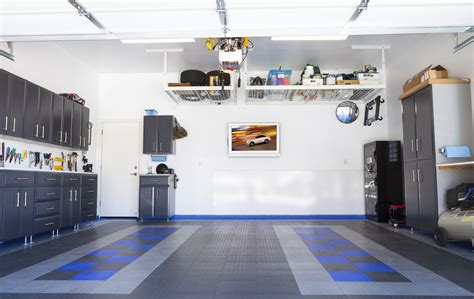Choosing the Right Layout for Efficiency
When it comes to setting up a workshop, one of the most important factors to consider is the layout. Choosing the right layout is essential for achieving maximum efficiency and productivity in your workspace. A well-designed layout can help streamline your workflow, minimize wasted time and effort, and allow you to work more effectively. In this blog post, we will explore some key considerations for choosing the right layout for efficiency in your workshop.
First and foremost, it is crucial to assess the available space in your workshop. Consider the dimensions, shape, and any structural limitations of the area. This will help you determine the ideal arrangement of workstations, machinery, and storage units. Proper utilization of space is crucial for avoiding clutter and ensuring a smooth workflow.
Next, consider the workflow and how different workstations and equipment will interact with each other. You should arrange your tools and equipment in a logical sequence, allowing for efficient movement between work areas. For example, placing a workbench near the materials storage area can save time and effort when accessing the necessary materials for a project.
- Size and Shape: Assess the available space and take into account any structural limitations.
- Workflow: Arrange workstations and equipment in a logical sequence to optimize movement and efficiency.
- Accessibility: Ensure that tools, materials, and equipment are easily accessible to minimize wasted time.
| Pros | Cons |
|---|---|
| Efficient workflow | Limited flexibility |
| Maximized use of space | Potential difficulty in rearranging later |
| Reduced clutter | Potential for ergonomic issues |
In addition to these considerations, it is vital to prioritize safety and ease of access in your workshop layout. Make sure to keep clear pathways and eliminate any obstructions that could cause accidents. Install proper lighting and ventilation to provide a comfortable and safe working environment.
Ultimately, the right layout for your workshop will depend on your specific needs and preferences. Take the time to carefully plan and experiment with different arrangements to find the one that works best for you. Remember, an efficient layout can greatly enhance your productivity and enjoyment in the workshop.
Must-Have Tools and Equipment for Every Workshop
In a workshop, having the right tools and equipment is crucial for optimal efficiency and productivity. Whether you are a professional woodworker or an amateur DIY enthusiast, there are certain must-have tools that should be a part of every workshop. These tools not only help in completing projects faster but also ensure the safety of the user. Let’s take a look at some of the essential tools and equipment that every workshop should have.
1. Power Tools: Power tools are a game-changer when it comes to efficiency in a workshop. Some of the must-have power tools include a drill, circular saw, jigsaw, and a cordless screwdriver. These tools help in cutting, drilling, and fixing materials, making them indispensable in any workshop.
2. Hand Tools: While power tools are essential, hand tools also play a crucial role in a workshop. Tools like a hammer, screwdrivers, chisels, wrenches, and pliers are all must-haves. They come in handy for small tasks, precision work, or when power tools are not applicable.
3. Safety Equipment: Safety should always be a top priority in any workshop. Personal protective equipment (PPE) such as safety glasses, gloves, and ear protection are a must to protect yourself from potential hazards. Additionally, fire extinguishers and first aid kits should be easily accessible in case of emergencies.
- 4. Workbenches and Workstations: A sturdy workbench or workstation is essential for any workshop. It provides a stable surface to work on and can have storage options to keep your tools organized. Consider investing in a quality workbench that suits your specific needs.
- 5. Measuring and Marking Tools: Accurate measurements are crucial for any woodworking or construction project. Having measuring and marking tools such as a tape measure, combination square, and marking gauge is essential for precise and professional results.
- 6. Storage Solutions: A well-organized workshop not only saves time but also enhances productivity. Use storage solutions like shelves, cabinets, and tool chests to keep your tools and equipment neatly arranged and easily accessible.
| Tool | Function |
|---|---|
| Drill | Make holes in various materials |
| Circular Saw | Cut straight lines through different materials |
| Jigsaw | Make curved cuts in wood or other materials |
| Hammer | Drive nails into surfaces or remove them |
| Screwdriver | Tighten or loosen screws |
| Chisels | Carve or remove materials with precision |
| Wrenches | Tighten or loosen nuts and bolts |
| Pliers | Hold, bend, or cut small objects |
These are just a few of the must-have tools and equipment for every workshop. The specific tools you need may vary depending on the type of projects you undertake, but having a well-rounded collection will ensure you are ready for any task that comes your way. Remember to always maintain and care for your tools properly to prolong their lifespan and prevent accidents. Happy workshop-ing!
Organizing Storage Systems to Maximize Space
One of the key challenges that DIY enthusiasts and professional craftsmen face in their workshop is the lack of space. With an ever-increasing collection of tools, materials, and supplies, it can be difficult to keep everything organized and easily accessible. That’s where organizing storage systems come in. By optimizing your workshop’s storage, you can maximize the available space and streamline your workflow, allowing you to work more efficiently.
There are various storage options available, each with its own advantages and disadvantages. The key is to choose the right storage system based on your workshop’s needs and the type of items you need to store. Wall-mounted cabinets are a popular choice as they make use of the vertical space in your workshop. They provide easy access to frequently used tools and keep them within arm’s reach. Tool chests and pegboards are also excellent options for organizing small tools and accessories while keeping them visible and easily accessible.
Additionally, consider incorporating modular shelving units that can be customized to fit your specific needs. These units can be adjusted and rearranged as your tool collection grows, ensuring every inch of available space is utilized efficiently. Stackable storage bins are another great solution for organizing small items like nails, screws, and bolts. They can be easily labeled and stacked on shelves or stored on wall-mounted racks to free up valuable workspace.
- Wall-mounted cabinets
- Tool chests and pegboards
- Modular shelving units
- Stackable storage bins
| Storage Option | Advantages | Disadvantages |
|---|---|---|
| Wall-mounted cabinets | – Utilize vertical space- Easy access to frequently used tools | – Limited storage capacity- May require installation |
| Tool chests and pegboards | – Keep small tools visible and accessible- Easy to rearrange | – Limited storage capacity- May take up wall space |
| Modular shelving units | – Customizable and adjustable- Utilize available space efficiently | – May require assembly |
| Stackable storage bins | – Easy to label and organize- Maximize small item storage | – Limited storage for larger tools- May require stacking |
When organizing your storage systems, it’s important to categorize and group similar items together. This will not only make it easier to locate items when needed but also make it more efficient to put them back in their designated places. Consider using color-coded labels or markers to identify different categories or types of tools.
In conclusion, by organizing storage systems in your workshop, you can maximize the available space and create a more efficient working environment. Wall-mounted cabinets, tool chests and pegboards, modular shelving units, and stackable storage bins are all excellent options to consider. Remember to categorize and group similar items together for easy access and to maintain an organized workspace. With a well-organized storage system, you’ll be able to focus more on your projects and less on searching for tools and materials.
Designing an Effective Workbench Area
When it comes to setting up a workshop, one of the most important areas to consider is the workbench. A well-designed workbench area can greatly enhance efficiency and productivity. It provides a dedicated space for carrying out various tasks, such as woodworking, crafting, or DIY repairs. In this blog post, we will explore important factors to consider when designing an effective workbench area to optimize your workflow and create a functional workspace.
First and foremost, choosing the right layout is crucial. The layout of your workbench area should be determined by the type of projects you will be working on and the tools and equipment you will need to access frequently. There are various layout options to consider, such as an L-shaped, U-shaped, or linear layout. Each has its own advantages and disadvantages, so it’s important to assess your specific needs before making a decision.
- Consider the workflow: Arrange the workbench, tools, and materials in a way that allows for a smooth workflow. Position frequently used tools within easy reach to minimize time wasted searching for them.
- Maximize workspace: Optimize the available space by utilizing vertical storage solutions such as pegboards, shelves, or wall-mounted cabinets. This will help keep your workbench clear and organized, allowing for more efficient work.
- Ensure proper lighting: Good lighting is essential for any workbench area. Natural light is ideal, but if that’s not possible, invest in bright, task-specific lighting. Position the light source in a way that minimizes shadows and provides optimal visibility.
In addition to the layout, organizing storage systems is another key aspect of designing an effective workbench area. A clutter-free workspace not only looks neater but also improves productivity. Utilize different storage options such as drawers, bins, and tool racks to keep tools and materials organized and easily accessible. Consider labeling the storage containers to further enhance efficiency.
| Organization Tip | Description |
|---|---|
| Tool outlines | Create outlines of your tools on the surface of your workbench to easily identify where each tool belongs. This promotes organization and makes it easier to find and put away tools after each use. |
| Modular storage | Invest in modular storage systems that can be easily rearranged and customized to accommodate your changing needs. This allows you to adapt your workbench area as your projects evolve over time. |
| Vertical storage | Utilize vertical space by installing shelves, pegboards, or wall-mounted organizers. This maximizes storage capacity and keeps tools within reach. |
Lastly, prioritize safety when designing your workbench area. Implementing safety measures is crucial to protect yourself and prevent accidents. Make sure you have a well-stocked first aid kit readily available. Install fire extinguishers in easily accessible locations. Consider using a non-slip mat under your workbench to prevent falls. Additionally, always wear proper safety equipment, such as goggles, gloves, and ear protection, when working with tools or chemicals.
In conclusion, designing an effective workbench area is essential for maximizing productivity and creating a functional workspace. By considering factors such as layout, storage organization, proper lighting, and safety measures, you can optimize your workbench area to enhance efficiency and ensure a secure workshop environment.
Creating Proper Lighting for Enhanced Visibility
When it comes to creating a well-functioning workshop, one aspect that often gets overlooked is the proper lighting. Having adequate lighting in your workshop is crucial for enhanced visibility, which ultimately leads to better accuracy and efficiency in your work. In this blog post, we will discuss the importance of proper lighting and some key factors to consider when designing the lighting for your workshop.
1. Importance of Proper Lighting:
Proper lighting in your workshop is essential for several reasons. Firstly, it helps prevent eye strain and fatigue, which can be a common issue when working in dimly lit spaces for an extended period. By providing sufficient lighting, you can reduce the risk of eye-related problems and maintain your productivity levels.
2. Factors to Consider:
When designing the lighting for your workshop, there are a few factors that you should consider. Firstly, you need to determine the appropriate level of brightness needed for your specific tasks. Different tasks may require different levels of lighting, so it’s important to assess your needs and adjust accordingly.
Secondly, consider the source of lighting. Natural light is always a great option as it provides a clear and bright environment. If natural light is not readily available, you can opt for a combination of overhead lighting and task lighting to achieve the desired brightness. Task lighting, such as adjustable desk lamps or focused spotlights, can be particularly useful for detailed or intricate work.
Lastly, think about the placement of the lights. It’s important to position the lights in a way that minimizes shadows and glare. Overhead lights should be evenly distributed throughout the workshop to ensure consistent lighting across the entire space. Additionally, consider using light reflectors or diffusers to soften the light and reduce harsh reflections.
3. Lighting Options:
There are several lighting options available for workshops. LED lights are a popular choice due to their energy efficiency and longevity. They also provide bright, white light that closely resembles natural daylight, making them ideal for workshops. Fluorescent lights are another option, offering a cost-effective solution with good coverage and brightness. However, they do have a slight delay in reaching full brightness and can flicker at times.
In conclusion, proper lighting is a crucial aspect of creating an efficient and productive workshop. By understanding the importance of lighting and considering key factors such as brightness levels, light sources, and placement, you can design a well-lit space that enhances visibility and maximizes your work efficiency.
Implementing Safety Measures for a Secure Workshop
When it comes to running a workshop, safety should always be a top priority. The measures you take to ensure the well-being of yourself and others can greatly reduce the risk of accidents and injuries. So, whether you’re a professional woodworker or a DIY enthusiast, it’s crucial to implement proper safety measures in your workshop. In this blog post, we will discuss some essential safety practices and precautions that every workshop should have.
1. Adequate Ventilation: Proper ventilation is essential in a workshop to remove dust, fumes, and other harmful substances. Ensure that your workshop has enough windows or vents to allow air circulation. Additionally, consider using a dust collection system to minimize respiratory risks.
2. Protective Gear: Wearing the right protective gear not only prevents injuries but also provides peace of mind. Make sure to equip yourself with safety glasses, ear protection, gloves, and a dust mask to shield against potential hazards.
3. Fire Safety: Fire prevention and preparedness are vital in a workshop. Install fire extinguishers at strategic locations and make sure they are easily accessible. Keep flammable materials stored properly and away from ignition sources. Regularly check and maintain electrical wiring to prevent short circuits.
4. Machine Maintenance: Regular maintenance of workshop machinery is crucial for safe operation. Keep equipment clean, lubricated, and in good working condition. Follow manufacturers’ instructions for maintenance and always use the machines as intended. If you notice any defects or issues, repair or replace the equipment immediately.
5. Proper Storage: Organize your workshop and keep tools and materials properly stored. Avoid clutter and maintain clear pathways to prevent tripping hazards. Store sharp objects such as saws and chisels in secure cabinets or racks to minimize the risk of accidental injuries.
6. Emergency Plan: Prepare an emergency plan that outlines procedures in case of accidents, injuries, or other emergencies. Make sure all workshop occupants are aware of the plan and know the locations of emergency exits, first aid kits, and safety showers. Regularly conduct drills to ensure everyone is familiar with the procedures.
7. Education and Training: Stay up to date with safety guidelines and regulations relevant to your workshop. Attend workshops or seminars on workshop safety practices. Additionally, provide proper training to anyone using the workshop, whether it’s employees or family members. Ensure they are aware of the potential risks and know how to operate equipment safely.
By implementing these safety measures in your workshop, you can create a secure environment where accidents are less likely to occur. Remember, safety should always be a priority, and taking the necessary precautions will help protect yourself and others in the workshop.
Incorporating Functional Flooring Options for Durability
When designing a workshop, one often focuses on the layout, tools, and storage systems, but one crucial aspect that is often overlooked is the flooring. The choice of flooring can greatly impact the functionality and durability of a workshop. It is important to select a flooring option that can withstand the heavy foot traffic, tools, and equipment commonly found in a workshop. In this blog post, we will explore some functional flooring options that not only provide durability but also offer various benefits to enhance the overall workshop environment.
One popular flooring option for workshops is concrete. Concrete floors are known for their strength and durability, making them an excellent choice for high-traffic areas. They can withstand heavy machinery, dropped tools, and spills without easily getting damaged. The smooth and hard surface of concrete also makes it easy to clean and maintain. However, concrete can be hard on the feet and is non-slip, which could be a concern for those who spend long hours standing in the workshop. Therefore, it is recommended to add anti-fatigue mats in specific work areas to provide comfort and reduce the risk of injuries.
If you prefer a more comfortable flooring option, rubber mats or tiles are an excellent choice. Rubber provides a cushioned surface that is gentle on the feet and joints, making it ideal for workshop environments where individuals may be standing for extended periods. Rubber flooring also offers excellent sound insulation, reducing noise and creating a quieter workspace. Additionally, rubber is resistant to chemicals and oils, making it easy to clean and maintain. However, it is important to choose rubber flooring specifically designed for workshops, as regular rubber mats or tiles may not have the necessary durability to withstand heavy machinery and tools.
An alternative flooring option to consider is epoxy flooring. Epoxy is a type of resin coating that can be applied to concrete floors, providing a seamless and durable finish. Epoxy flooring is highly resistant to chemicals, oils, stains, and impact, making it an ideal choice for workshops. It creates a smooth and glossy surface that is easy to clean and maintain. Epoxy flooring also offers customization options, allowing you to choose different colors and designs to create a visually appealing workshop. However, it is important to note that the installation of epoxy flooring requires professional expertise to ensure proper adhesion and durability.
- Concrete floors are known for their strength and durability.
- Rubber flooring provides a cushioned surface that is gentle on the feet and joints.
- Epoxy flooring is highly resistant to chemicals, oils, stains, and impact.
In conclusion, when designing a workshop, it is essential to give careful consideration to the flooring options available. Choosing a functional flooring option will not only enhance the durability of the workshop but also provide a comfortable and safe working environment. Whether opting for concrete, rubber, or epoxy flooring, each option offers its unique advantages that can significantly contribute to the overall efficiency and productivity of your workshop. So, don’t overlook the importance of incorporating functional flooring options in your workshop design!
Frequently Asked Questions
Question: How do I choose the right layout for efficiency in my workshop?
Answer: When choosing a layout for your workshop, consider factors such as workflow, accessibility, and ergonomics. Arrange your equipment and workstations in a way that allows for easy movement and efficient use of space.
Question: What are some must-have tools and equipment for every workshop?
Answer: Some essential tools and equipment for a workshop include a workbench, power tools (such as drills and saws), hand tools (such as screwdrivers and wrenches), a toolbox for storage, safety gear (like goggles and gloves), and measuring tools (such as a tape measure and level).
Question: How can I organize storage systems to maximize space in my workshop?
Answer: To maximize space in your workshop, utilize various storage options such as shelves, cabinets, pegboards, and drawer organizers. Categorize and label your tools and materials for easy identification and accessibility.
Question: What should I consider when designing an effective workbench area?
Answer: When designing a workbench area, consider its size, height, and stability. Ensure it has sufficient space for your projects, is at a comfortable working height, and is sturdy enough to support your tools and materials.
Question: How can I create proper lighting for enhanced visibility in my workshop?
Answer: To create proper lighting in your workshop, install bright overhead lights and additional task lighting near workstations. Consider using LED lights for energy efficiency and placing lights at different angles to minimize shadows.
Question: What safety measures should I implement in my workshop?
Answer: Some important safety measures for a workshop include wearing appropriate safety gear, keeping the area clean and free from clutter, using tools properly and safely, having a fire extinguisher on hand, and following proper electrical safety guidelines.
Question: What flooring options are functional for a durable workshop?
Answer: When choosing flooring for a workshop, opt for options that are durable, easy to clean, and resistant to damage. Some popular choices include epoxy coatings, rubber mats, concrete sealers, and interlocking floor tiles.





